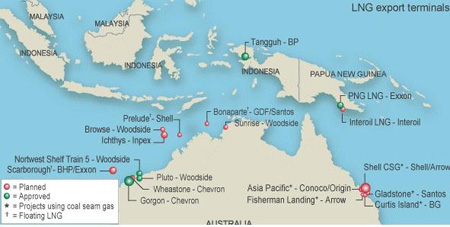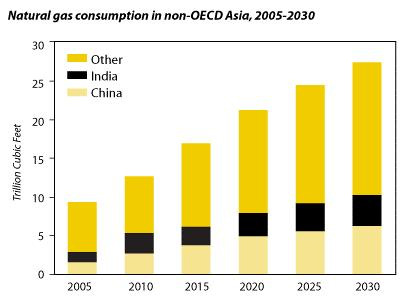The growing market and demand for liquefied natural gas (LNG) is described as "a long-term game" by various researchers and energy analysts because of its sustained economic benefits and as measured as a partial solution to the world's growing energy demand. The LNG market is becoming increasingly important to the Australian economy, and global energy security as well as a major export commodity.
There are 14 LNG plants either under construction or firmly committedto be constructed around the world, out of which eight are located in Australia, and there remain a few more in a pre-feasibility stage.

Photo Credit: iStockphoto.com
According to the BP World Energy Outlook, natural gas demand should grow at 2.1 percent annually to 2030 and non- Organisation for Economic Co-operation and Development (OECD)countries will account for 80 percent of this demand growth.Australia is well-placed to build long-term energy partnerships with countries across its region on the back of its expanding natural gas (LNG) resource base.
Australian (LNG) development
Currently, in Australia there are two LNG operating facilities in Darwin and the North West Shelf with the production of around 20 million tonnes of LNG annually. In addition, eight LNG projects are under construction with a potential output of 61 million tons (mt/year).In Australia most conventional natural gas reserves are concentrated in Carnarvon, Browse and the Bonaparte basins off the north-west coast and also in south-west, south-east and central Australia.

Source: California Energy Commission
Based on currently operating LNG and proposed projects, the country expects to increase output three fold by 2015. According to the International Energy Agency (IEA), if projects either proposed or under construction come online the country will contribute significantly to future global LNG production and trade and would become the world's second-largest LNG exporter behind Qatar (Figure 1). In addition, Australia has a great potential to produce LNG from unconventional resources including from coal seam gas (CSG).
To this end, three CSG-to-LNG projects are proposed on Australia's the east coast. Mainly, Australia's export market includes Japan, China, South Korea and Taiwan and likely further market expansion to India and Singapore as the country's LNG capacity increases.
Coal seam gas-to-LNG
The exploitation of unconventional resources is becoming commercially viable mainly because of increasing global energy commodity prices and advancements in technology.The US is the most advanced country in developing its unconventional resources.Australia's CSG proven reserves areestimated to be between 250 trillion cubic feet (tcf) to more than 300tcf.Mostly, CSG reserves are located in the Bowen and Surat basins of Queensland and the Sydney basin in New South Wales.
In Queensland and New South Wales, gas produced from seams of coal accounted for 13 percent of the nation's natural gas production in 2010.Currently, around 5,000 CSG wells have been drilled in Queensland and the world's first major CSG-to-LNG project is underway near Gladstone along with three other proposed projects, with the first cargoes expected in late 2014.
Australia and LNG demand outlook
Natural gas is demand is forecast to rise especially in non-OECD economies like China, India (more than 5 percent per year) and the Middle East (Figure 2).In addition,Japan is expected to continue its strong demand for gas imports following the Fukushima nuclear disaster in 2011. The rapid economic growth in Asian economies, predominantly in China, has translated into strong demand for Australia's energy resources.
According to the IEA, China will absorb one-third of global LNG supply as the world's largest LNG importer by 2035, which in turn reflects a shift in the global centre of economic gravity. As a result China will play a significant role in Australia's LNG supply outlook and contribute to an increase in the global LNG trade.
Figure 2: Projected gas demand in non-OECD economies

Source: FACTS Global Energy
Certainly, Australia is well-placed to meet China's rapidly-growing energy demand, offering a secure long-term supply, and attaining enormous economic benefits for its own economy. Because of the natural complementarities between two countries, Australia will continue to build a long-term relationship with China and play an increasingly important role in itseconomic development.
What could constrain Australian CSG-sourced LNG supply confronting socio-economic and environmental impacts
The development of coal seam gas resources is transforming the world's LNG supply outlook. For Australia the industry is expected to feed both domestic demand and its LNG export markets. In spite of this the coal seam gas industry is becoming increasingly controversial within Australia and is facing resistance against its development, especially due to perceived environmental impacts. Recently, in New South Wales, the Lismore City Council placed a moratorium on all CSG activity, including seismic testing, drilling and associated activities.
There are various real or perceived social and environmental impacts associated with CSG development. Typically, large amounts of water are produced during the process of CSG extraction and may affect the levels and flow of groundwater in surrounding aquifer systems. Extraction of groundwater may also cause some surface subsidence, depending on the site. In addition, ground water contamination due to usage of toxic chemicals in the fracking process is perceived as high risk.
The surface footprint of CSG infrastructure is generally less intensive than other industries such as mining. However, some complain that the distribution of developments fragments local habitats and agricultural landscapes and may compromise the scenic and aural quality of the landscape. Mostly, CSG fields underlie agricultural land and depend on existing infrastructure and social services. Major social impacts from CSG developments are likely to flow from the access and use of land and water resources, the competing demands placed on human capital and social infrastructure.
CSG development is further complicated by other perceived challenges, including those to existing rural communities' identities and way of life. Finally, the industry's influence on the local availability of natural and social resources (water, housing, etc.) is often a point of contention by those opposed to CSG development.Substantiated or not, these perceptions create tensions at the local and regional levels. Clearly some individuals and local communities have motivations beyond any economic benefits associated with CSG development, but these must be accounted for in addressing concerns and protests towards CSG development.
The China-Australia relationship: A recognised challenge
As Australia plans for its own economic gas bonanza, many analysts are raising those vulnerabilities associated with Australia's energy relationships, particularly in regard to China. The absence of Chinese demand would raise significant questions about the commercial viability of various LNG projects.Apart from the energy partnership, China and Australia must view their relationship as a strategic one while strengthening their economic relationships. In addition, the relationship between China and the US will be of fundamental importance to Australia and how Australia manages its bilateral relationship with both China and the US.
Undoubtedly, China views Australia as an ideal energy supplier but not exclusively. In addition, the Turkmen gas pipeline to China is already providing a considerable amount of gas to the country and there are discussions concerning developing another pipeline to increase Turkmen gas deliveries. Also, an anticipated pipeline between Russia and China is gaining momentum and the deal will be economically viable for China comparable with LNG imports.
These development could, of course, have major impacts on China's appetite for Australia's LNG.
Conclusion
Australia is well-placed to take advantage of the considerable opportunities presented by the strong demand for energy resources, especially from non-OECD nations in Asia and predominantly by China. Australia is one of the largest potential suppliers of LNG to the Asia-Pacific region, with several proposed projects over the coming decades. In addition, the country's CSG-sourced LNG supply outlook is promising particularly for China. It is likely that this burgeoning industry will build on its current momentum to substantially transform the Australian energy landscape over the near future.
The question then remains on whether Australia will be able to expand its CSG development to increase its LNG capacity. The changing global economic environment, alternative suppliers such as Qatar, real or perceived environmental impacts related to CSG development, and the sustainability of the China-Australia energy and strategic partnership, are potential risk factors to the country's prosperous future. In addition, unconventional gas production in China, India, and Canada and particularly in the US could have significant impacts upon the LNG market, and therefore impact on Australia's CSG and broader LNG outlook.
Contributor Muhammad Makki is a PhD candidate at School of Journalism and Communication & Sustainable Mineral Institute, The University of Queensland, Australia.
BY: Muhammad Makki, IAGS